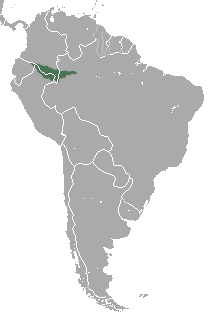Lucifer spring monkey
| Lucifer spring monkey | ||||||||||||
|---|---|---|---|---|---|---|---|---|---|---|---|---|

Lucifer spring monkey ( Cheracebus lucifer ) |
||||||||||||
| Systematics | ||||||||||||
|
||||||||||||
| Scientific name | ||||||||||||
| Cheracebus lucifer | ||||||||||||
| ( Thomas , 1914) |
The Lucifer spring monkey ( Cheracebus lucifer , Syn . : Callicebus lucifer ) is a primate species from the subfamily of the spring monkeys within the family of the sakia monkeys (Pitheciidae). It was formerly considered a subspecies of the collared jumper .
features
Like all jumper monkeys, Lucifer's jumper monkeys are relatively small primates with a long, bushy tail, fluffy fur and a small, rounded head. The fur is mostly black or black-gray, on the back the color changes into brownish or reddish. The head is black on the upper side, on the throat there is a transverse, white collar drawing. The hands are strikingly orange. As with all jumper monkeys, the hind legs are relatively long; the tail, which is longer than the body, cannot be used as a prehensile tail.
distribution and habitat
Lucifer jugular monkeys live in the western Amazon basin in southern Colombia , western Brazil , eastern Ecuador, and northern Peru . Their distribution area is limited in the north by the Japurá and in the south by the Solimões . Forests are their habitat.
Way of life
Little is known about the way of life of the Lucifer jumper monkeys; it probably corresponds to that of the other jumper monkeys. They are diurnal and mostly stay in the trees. There they either move on all fours or jump. Jumper monkeys live in monogamous family groups in which the partners often stay together for life. These groups live in a fixed territory, which they mark with morning duets. Their diet consists mainly of fruits, to a lesser extent they eat leaves and other parts of plants as well as insects. The fathers take an intensive part in raising the young, they carry the young and only make the mother suckle it.
Danger
Lucifer apes live in a relatively large, sparsely populated area and are not considered endangered according to the IUCN .
literature
- Thomas Geissmann : Comparative Primatology. Springer-Verlag, Berlin et al. 2003, ISBN 3-540-43645-6 .
- Marc GM van Roosmalen, Tomas van Roosmalen and Russell A. Mittermeier: A Taxonomic Review of the Titi Monkeys, Genus "Callicebus" Thomas 1903, with the description of two new species: "Callicebus bernhardi" and "Callicebus stephennashi", from Brazilian Amazonia . In: Neotropical Primates. 10, 2002, ISSN 1413-4703 , pp. 1-52, PDF .
- Don E. Wilson, DeeAnn M. Reeder (Eds.): Mammal Species of the World. A taxonomic and geographic Reference. Johns Hopkins University Press, Baltimore MD 2005, ISBN 0-8018-8221-4 .
